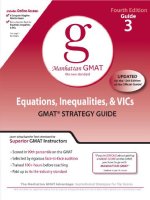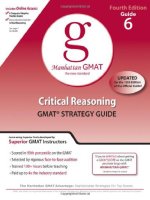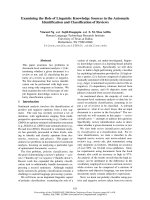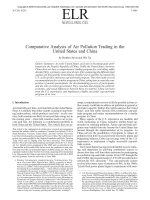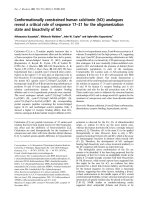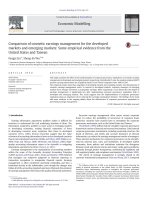Prep manhattan GMAT set of 8 strategy guides 03 the equations, inequalities, and VICs guide 4th edition
Bạn đang xem bản rút gọn của tài liệu. Xem và tải ngay bản đầy đủ của tài liệu tại đây (3.22 MB, 202 trang )
Includes Online
Access:
~ 6 Computer Adaptive
PractIce Exams
~
Bonus Question Bank for
Equations, Inequalities,
"VICs
See page 7
for details.
9rtanhattan G MAT
the new standard
Learn using Superior Tools developed by
Superior GMAT Instructors
• Scored in 99th percentile on the GMAT
• Selected by rigorous face-to-face audition
•Trained 100+ hours before teaching
• Paid up to 4x the industry standard
you're SERIOUSabout getting
a GREATSCOREon the GMAT;
you have to go with
Off
MANHATTAN GMAT."
- Student at top 5 b-school
The Manhattan GMAT Advantage: Sophisticated Strategies For Top SCi
GMAT and GMAC are reqlstered trademarks
of tile Gra.L2ce
Management Admission Council which neither sponsors nor endor
9danliattanG MAT'Prep
the new standard
1. BASIC EQ.UATIONS
11
In Action Problems
Solutions
23
25
2. EQ.UATIONS WITH EXPONENTS
29
In Action Problems
Solutions
35
37
3. Q.UADRATIC EQ.UATIONS
41
In Action Problems
Solutions
49
51
4.FO~
55
In Action Problems
Solutions
63
65
5. FUNCTIONS
69
In Action Problems
Solutions
79
81
6. INEQ.UALITIES
83
In Action Problems
Solutions
103
105
7. VICS
107
In Action Problems
Solutions
123
125
8. STRATEGIES FOR DATA SUFFICIENCY
131
Sample Data Sufficiency Rephrasing
137
9. OFFICIAL GUIDE PROBLEMS: PART I
143
Problem Solving List
Data Sufficiency List
146
147
PART!:
GENERAL
TABLE OF CONTENTS
:ManliattanG MAT·Prep
the new standard
10. EQUATIONS: ADVANCED
149
In Action Problems
Solutions
157
159
11. FORMULAS & FUNCTIONS:
ADVANCED 163
In Action Problems
Solutions
12. INEQUAUTIES:
173
175
ADVANCED
179
In Action Problems
Solutions
187
189
13. ADDITIONAL VIC PROBLEMS
193
In Action Problems
Solutions
195
197
14. OFFICIAL GUIDE PROBLEMS: PART II
201
Problem Solving List
Data Sufficiency List
204
205
PART II:
ADVANCED
TABLE OF CONTENTS
Chapter 1
-~'-'-o/-
··.·i.:
EQUATIONS, INEQUALIn~,
BASIC
EQUATIONS
.". '...
& VIes
In This Chapter . . .
• Solving One-Variable Equations
• Simultaneous
Equations: Solving by Substitution
• Simultaneous
Equations: Solving by Combination
• Simultaneous
Equations: Three Equations
• Mismatch Problems
• Combo Problems: Manipulations
• Testing Combos in Data Sufficiency
• Absolute Value Equations
BASIC EQUATIONS. STRATEGY
Chapter 1
BASIC EQUATIONS
Algebra is one of the major math topics tested on the GMAT. Your ability to solve
equations is an essential component of your success on the exam.
Basic GMAT equations are those that DO NOT involve exponents. The GMAT expects
you to solve several different types of BASIC equations:
1)
2)
3)
4)
5)
An equation with 1 variable
Simultaneous equations with 2 or 3 variables
Mismatch equations
Combos
Equations with absolute value
To solve basic equations,
remember that whatever
Several of the preceding basic equation types probably look familiar to you. Others-particularly Mismatch Equations and Combos-are
unique GMAT favorites that run counter to
some of the rules you may have learned in high-school algebra. Becoming attuned to the
particular subtleties of GMAT equations can be the difference between an average store and
an excellent one.
Solving One-Variable Equations
Equations with one variable should be familiar to you from previous encounters with. algebra. In order to solve one-variable equations, simply isolate the variable on one side of the
equation. In doing so, make sure you perform identical operations to both sides of the
equation. Here are three examples:
3x+ 5 = 26
3x= 21
x=7
w= 17w-l
0= 16w- 1
1 = 16w
Subtract 5 from both sides.
Divide both sides by 3.
7 is the solution of the given equation.
Subtract w from both sides.
Add 1 to both sides.
Divide both sides by 16.
1
-=w
16
1...+3=5
9
Subtract 3 from both sides.
Multiply both sides by 9.
9danfiattanGMAIPrep
the new standard
you do to one side. you
must also do to the other
side.
Chapter 1
BASIC EQUATIONS STRATEGY
Simultaneous Equations: Solving by Substitution
Sometimes the GMAT asks you to solve a system of equations with more than one variable.
You might be given two equations with two variables, or perhaps three equations with three
variables. In either case, there are two primary ways of solving simultaneous equations:
by substitution or by combination.
Solve the following for
x and y.
x+y=9
2x= Sy+ 4
Use substitution whenev-
1. Solve the first equation for x. At this point, you will not get a number, of course.
er one variable can be
easily expressed in terms
of the other.
x+y=9
x=9-y
2. Substitute this expression involvingy into the second equation wherever x appears.
2x= 5y+4
2(9 - y) = 5y + 4
3. Solve the second equation for
y. You will now get a number for y.
2(9 - y) = 5y + 4
18 - 2y= 5y+4
14 = 7y
2=y
4. Substitute your solution for y into the first equation in order to solve for x.
x+y=9
x+2=9
x=7
:ManliattanG MAT·Prep
the new standard
BASIC EQUATIONS STRATEGY
Chapter 1
Simultaneous Eqaations, Solving by Combination
Alternatively, you can solve simultaneous equations by combination.
subtract the two equations to eliminate one of the variables.
Solve the following for
In this method, add or
x and y.
x+y=9
2x= Sy+ 4
1. Line up the terms of the equations.
Use combination whenever it is easy to manipulate the cqlWions so that
the codBcients fur one
variable are the SAME or
x+y=9
2x- 5y= 4
2. If you plan to add the equations, multiply one or both of the equations so that the coefficient of a variable in one equation is the OPPOSITE of that variable's coefficient in the
other equation. If you plan to subtract them, multiply one or both of the equations so that
the coefficient of a variable in one equation is the SAME as that variable'scoeffldenr in the
other equation.
-2 (x + y= 9)
2x- 5y= 4
-2x-2y=-18
2x- 5y= 4
OPPOSITE.
Note that the x coefficients are
now opposites.
3. Add the equations to eliminate one of the variables.
-2x-2y =-18
+ 2x- 5y = 4
-7y=-14
4. Solve the resulting equation for the unknown variable.
-7y=-14
y=2
5. Substitute into one of the original equations to solve for the second variable.
x+y=9
x+2=9
x=7
9danliattan·6MAVPrep
the new standard
15
Chapter 1
BASIC EQUATIONS STRATEGY
Simultaneous Equations: Three Equations
The procedure for solving a system of three equations with three variables is exactly the
same as for a system with two equations and two variables. You can use substitution or
combination. This example uses both:
Solve the following for WI XI and y.
Solve three simultaneous
equations step-by-step.
Keep careful track of
X+W=y
2y+ W= 3x- 2
13 - 2w=x+ Y
your work to avoid careless errors, and look for
1. The first equation is already solved for y.
ways to reduce the number of steps needed to
y=x+w
solve.
2. Substitute for y in the second and third equations.
Substitute for
y in the second equation:
2(x+ w) + w= 3x- 2
2x + 2w + w = 3x - 2
-x+3w=-2
Substitute for y in the third equation:
13 - 2w = x + (x + w)
13 -2w=2x+
3w+ 2x= 13
w
3. Multiply the first of the resulting two-variable equations by (-1) and combine them with
addition.
x- 3w= 2
+ 2x+3w=13
3x= 15
Therefore, x = 5
4. Use your solution for x to determine solutions for the other two variables.
3w+ 2x= 13
3w+ 10 = 13
3w=3
w=1
y=x+w
y=5+1
y=6
The preceding example requires a lot of steps to solve. Therefore, it is unlikely that the
GMAT will ask you to solve such a complex system-it
would be difficult to complete in
two minutes. Here is the key to handling systems of three or more equations on the
GMAT: look for ways to simplify the work. Look especially for shortcuts or symmetries in
the form of the equations to reduce the number of steps needed to solve the system.
:M.anliattanG MAT'Prep
16
the new standard
BASIC EQUATIONS STRATEGY
Chapter 1
Take this system as an example:
What is the sum of
X,
y and z?
x+y=8
x+z=l1
y+z=7
In this case, DO NOT try to solve for x, y, and z individually. Instead, notice the symmetry
of the equations-each
one adds exacdy two of the variables-and
add them all together:
x + y
=
x
+ z=
+ + y+ z=
2x+ 2y+ 2z=
Therefore, x
8
11
Do not assume that the
number of equations
must be equal to the
number of variables.
7
26
+ y + z is half of 26, or 13.
Mismatch Problems
Consider the following rule, which you might have learned in a basic algebra course: if you
are trying to solve for 2 different variables, you need.Z equations. If you are trying to solve
for 3 different variables, you need 3 equations, etc. The GMAT loves. to trick you by.taking
advantage of your faith in this easily misapplied rule.
MISMATCH problems, which are particularly common on the Data Sufficiency portion of
the test, are those in which the number of unknown variables does NOT correspond to the
number of given equations. Do not try to apply that old rule you learned in high-school
algebra. All MISMATCH problems must be solved on a case-by-case basis. Try the following Data Sufficiency problem:
What is x?
(1)
3x
3y+Sz
8
(2) 6y
+ 10z = 18
It is tempting to say that these two equations are not sufficient to solve for x, since there are
3 variables and only 2 equations. However, the question does NOT ask you to solve for all
three variables. It only asks you to solve for x, which IS possible:
First, get the x term on one
side of the equation:
3x
=8
3y+ 5z
3x = 8(3y + 5z}
Then, notice that the second equation gives
us a value for 3y + 5z, which we can substitute
into the first equation in order to solve for x:
3x = 8(3y + 5z)
3x= 8(9)
x= 8(3) = 24
6y+ lOz= 18
2(3y + 5z) = 18
3y+ 5z= 9
The answer is (C): BOTH statements TOGETHER
are sufficient.
~anhattanGMAT·Prep
the new standard
17
Chapter 1
BASIC EQUATIONS STRATEGY
Now consider an example in which 2 equations with 2 unknowns are actually NOT
sufficient to solve a problem:
What isx?
(1) y = x3-1
(2) y=x-1
It is tempting to say that these 2 equations are surely sufficient to solve for x, since there are
2 different equations and only 2 variables. However, notice that if we take the expression for
y in the first equation and substitute into the second, we actually get multiple possibilities
for x. (In Chapter 3, we will learn more about how to solve these sorts of equations.)
Follow through with the
algebra on potential
x3 -1 = x-I
mismatch problems to
x(x + I)(x -1) =
determine whether a
single solution is possible.
°
x= {-I,O,I}
Because of the exponent (3) on x, it turns out that we have THREE possible values for x. If
x equals either -1, 0, or 1, then the equation x3 = x will be true. We can say that this equation has three solutions or three roots. Therefore, we cannot find a single value for x. The
answer to the problem is (E): the statements together are NOT sufficient.
Now consider another example in which 2 equations with 2 unknowns are actually NOT
sufficient to solve a problem. This time, it looks as if we are avoiding exponents altogether:
What is x?
(1)
x- Y = 1
(2) xy= 12
Again, it is tempting to say that these 2 equations are sufficient to solve for x, since there
are 2 equations and only 2 variables. However, when you actually combine the two equations, you wind up with a so-called "quadratic" equation. An exponent of 2 appears naturally in the algebra below, and we wind up with two solutions or roots. (Again, we will cover
the specific solution process for quadratic equations in Chapter 3.)
x-y=1
y
x-l=
= 12
x(x-l)
2
x -x= 12
2
x -x-I2=
(x-4)(x+3)
=
°
°
x=4 or x=-3
The combined equation has two solutions or roots. Although we have narrowed down the
possibilities for x to just two choices, we do NOT have sufficient information to solve
uniquely for x. Again, the answer is (E): the statements together are NOT sufficient.
91tanliattanG MAT·Prep
18
the new standard
BASIC EQUATIONS STRATEGY
Chapter 1
A MASTER RULE for determining whether 2 equations involving 2 variables (say, x and y)
will be sufficient to solve for the variables is this:
(1) If both of the equations are linear-that
is, if there are no squared terms (such as x2
or y2) and no xy tercns-the equations will be sufficient UNLESS the two equations
are mathematically identical (e.g., x + y = 10 is identical to 2x + 2y = 20).
(2) If there are ANY non-linear terms in either of the equations (such as Xl, y2, xy, or
-=-), there will USUALLY be two (or more) different solutions for each of the variy
With 2 equations and 2
ables and the equations will not be sufficient.
unknowns, linear equa-
Examples:
tions usually lead to one
solution, and nonlinear
What is x?
What is x?
equations usually lead to
2 (or more) solutions.
=
(1) 2x + 3y 8
(2) 2x - v= 0
(1)x2+,y=
17
(2) r = 2x+ 2
Because both of the equations are
linear, and because they are not
mathematically identical, there is
=
=
only one solution (x 1 and y 2)
so the statements are SUFFICIENT
TOGETHER (answer C).
Because there is an x2 term in equation 1, as usual there are two solutions for x and y (x = 3 and y = 8, or
x -5 and y -8), so the statements
are NOT SUFFICIENT, even together
(answer E).
=
=
Combo Problems: Manipulations
The GMAT often asks you to solve for a combination of variables, called COMBO
lems. For example, a question might ask, what is the value of x +y?
prob-
In these cases, since you are not asked to solve for one specific variable, you should generally NOT try to solve for the individual variables right away. Instead, you should try to
manipulate the given equation(s) so that the COMBO is isolated on one side of the equation. Only try to solve for "the individual variables after you have exhausted all other
avenues.
There are four easy manipulations that are the key to solving most COMBO problems. You
can use the acronym MADS to remember them.
M: Multiply or divide the whole equation by a certain number.
A: Add or subtract a number on both sides of the equation.
D: Distribute or factor an expression on ONE side of the equation.
S: Square or unsquare both sides of the equation.
YWanliattanGMAT"Prep
the new standard
Chapter 1
BASIC EQUATIONS STRATEGY
Here are three examples, each of which uses one or more of these manipulations:
7-y
If x = -2-'
what is 2x + y?
7-y
x=--
Here, getting rid of the denominator by multiplying both sides of the equation by 2 is the key to
isolating the combo on one side of the equation.
2
2x=7 - Y
2x+y=7
If
To solve for a variable
combo, isolate the
combo on one side of
the equation.
.J2t +r
= 5, what
is 3r + 6t?
(v2t+rY= 52
2t+ r= 25
6t+ 3r= 75
If a(4 - c)
= 2ac + 4a + 9, what
4a-ac=2ac+4a+9
=ac= 2ac+ 9
-3ac= 9
ac= -3
Here, getting rid of the square root by squaring
both sides of the equation is the first step. Then,
multiplying the whole equation by 3 forms the
combo in question.
is ac?
Here, distributing the term on the left-hand side of
the equation is the first key to isolating the combo
on one side of the equation; then we have to subtract
2ac from both sides of the equation.
9danliattanG MAT'Prep
the new standard
•
BASIC EQUATIONS STRATEGY
Chapter 1
Testing Combos in Data Sufficiency
Combo problems occur most frequently in Data Sufficiency. Whenever you detect thilt a
Data Sufficiency question may involve a combo, you should try to manipulate the given
equation(s) in either the question or the statement, so that the combo is isolated on one
side of the equation. Then, if the other side of an equation from a statement contains a
VALUE, that equation is SUFFICIENT. If the other side of the equation contains a VARIABLE EXPRESSION, that equation is NOT SUFFICIENT.
2
~?
What is
Avoid attempting
x
x+y
variables in a combo
(1)-=3
y
problem. unless there is
no obvious alternative.
(2) x+y=12
First, rephrase the question by manipulating
the given expression:
2 x 2x
x
1 x
-x-=-=-=-x-=?
Y 4
4y
2y
2 Y
Now, we can ignore the 1/2 and isolate the combo we are looking for:
I
x
- =?
We are looking for the ratio of x to y.
y
x
Manipulate statement (1) to solve for - on one side of the equation. Since the other side of
y
the equation contains a VALUE, statement (1) is SUFFICIENT:
x+Y=3
y
x=2y
x+ y=3y
~=2
Y
x
Manipulate statement (2) to solve for - on one side of the equation. Since the other side of
y
the equation contains a VARIABLE EXPRESSION,
x+y=12
x
to
solve for the individual
Statement (2) is INSUFFICIENT:
x 12- y
-=-y
y
= 12- Y
The key to solving this problem easily is to AVOID trying to solve for theindividllalvari-
ables.
9danliattanGM.AT·Prep
the new standard
Chapter 1
BASIC EQUATIONS STRATEGY
Absolute Value Equations
Absolute value refers to the POSITIVE value of the expression within the absolute value
brackets. Equations that involve absolute value generally have 1WO SOLUTIONS. In
other words, there are 1WO numbers that the variable could equal in order to make the
equation true. The reason is that the value of the expression inside the absolute value brackets could be POSITIVE OR NEGATIVE. For instance, if we know
5, then x could
be either 5 or -5, and the equation would still be true.
1xl =
Do not forget to check
each of your solutions to
It is important to consider this rule when thinking about GMAT questions that involve
absolute value. The following three-step method should be used when solving for a variable
expression inside absolute value brackets. Consider this example:
absolute value
Solve for
equations by putting
each solution back into
the original equation.
w, given that 12 + 1 w - 41 = 30.
Step 1. Isolate the expression within the absolute value brackets.
12
+ 1 w - 41 = 30
Iw-41=18
Step 2. Once we have an equation of the form
Ixl = a with a > 0, we know
that
x = ± a.
Remove the absolute value brackets and solve the equation for 2 different cases:
CASE 1: x
= a (x is positive)
CASE 2: x
w- 4 = 18
w=22
= -a
(x is negative)
w-4=-18
w=-14
Step 3. Check to see whether each solution is valid by putting each one back into the original equation and verifying that the two sides of the equation are in fact equal.
In case 1, the solution, w
In case 2, the solution, w
Consider another example:
Solve for n, given that
= 22, is valid because 12 + 122 - 41 = 12 + 18 = 30.
= -14, is valid because 12 + 1-14 - 41 = 12 + 18 = 30.
I n + 91-
3n
= 3.
Again, isolate the expression within the absolute value brackets and consider both cases.
1.
I n + 91 = 3 + 3n
2.
CASE 1: n
n
+ 9 is positive:
+ 9 = 3 + 3n
CASE 2: n
n
+ 9 is negative:
+ 9 = -(3 + 3n)
n=-3
n=3
= 3, is valid because I (3) + 91- 3(3) = 12 - 9 = 3.
solution, n = -3, is NOT valid, since 1(-3) + 91- 3(-3) = 6 + 9 = 15.
3. The first solution, n
However, the second
This solution fails because when n = -3, the absolute value expression (n + 9 = 6) is not
negative, even though we assumed it was negative when we calculated that solution.
The possibility of a failed solution is a peculiarity of absolute value equations. For most
other types of equations, it is good to check your solutions, but doing so is less critical.
9.1.anliattanG MAT·Prep
the new standard
IN ACTION
BASIC EQUATIONS
PROBLEM SET
Chapter 1
Problem Set
For problems #1-5, solve for all unknowns.
1.
3x-6
--=x-6
5
2.
x+2
5
---4+x
9
-I y + 141 = 20
3.
22
4.
y = 2x + 9 and 7x
5.
a + b = 10, b + c = 12, and a + c = 16
+ 3y = -51
For problems #6-8, determine whether it is possible to solve for x using the given equations.
(Do not solve.)
.[;.
To
6.
-=Tand-=14
60
4
7.
3x + 20 = 8 and 60 = 24 - 9x
8.
30 + 2b + x = 8 and 120 + 8b + 2x = 4
For problems #9-12, solve for the specified expression.
9.
Given that x + y = 17, what is x + y?
3
10.
Given that
11.
Given that lOx + lOy = x + y + 81, what is x + y?
12.
Given that b+o =2 and 0+b=8, what is a?
20
a:
b = 21, what is ~?
For #13-15, write the expression in factored form (if distributed) and in distributed form (if
factored):
15.
(q
+ r)(s H)
9danliattanG MAT·Prep
the new standard
23
IN ACTION ANSWER KEY
BASIC EQUATIONS SOLUTIONS
Chapter 1
1. x= 12:
3x-6
--=x-6
5
3x - 6 = 5(x - 6)
3x-6 = 5x-30
24= 2x
12 =x
Solve by multiplying both sides by 5 to eliminate
the denominator. Then, distribute and isolate the
variable on the left side.
x+2
5
---4+x
9
9(x + 2) = 5(4 + x)
9x + 18 = 20 + 5x
4x=2
1
x=-
Cross-multiply to eliminate the denominators.
distribute and solve.
Then,
2
3.y={-16,
-12}:
First, isolate the expression within the absolute value brackets. Then, solve for two cases, one in which the expression
is positive and one in which it is negative. Finally, test the
validity of your solutions.
22-ly+141
=20
Iy+ 141 = 2
Case l:y+ 14
=2
Case 2:y
y=-12
y=-16
Case 1 is valid because 22 -1-12
Case 2 is valid because 22 -1-16
4. x= -6;y=
y=2x+9
+ 14 = -2
+ 141 = 22 - 2 = 20.
+ 141 = 22 - 2 = 20.
-3:
7x+3y=-51
7x+ 3(2x+ 9) = -51
7x+ 6x+ 27 = -51
13x+ 27 = -51
13x= -78
x=-6
Solve this system by substitution. Substitute the value
given for y in the first equation into the second equation. Then, distribute, combine like terms, and solve.
Once you get a value for x, substitute it back into the
first equation to obtain the value of y.
y = 2x + 9 = 2(-6) + 9 =-3
5. a = 7; b = 3; c = 9: This problem could be solved by an elaborate series of substitutions. However,
because the coefficients on each variable in each equation are equal to 1, combination proves easier. Here is
one way, though certainly not the only way, to solve the problem:
:M.annattanGMAl~Prep
the new standard
25
Chapter 1
IN ACTION ANSWER KEY
BASIC EQUATIONS SOLUTIONS
a + b
= 10
b + c = 12
a
+ c = 16
First, combine all three equations by adding them
together. Then divide by 2 to get the sum of all three
equations. Subtracting any of the original equations
from this new equation will solve for one of the variables, and the rest can be solved by plugging back
into the original equations.
2a + 2b + 2c= 38
a + b + c
-(a + b
= 19
=
10)
c=9
b + 9 = 12
a + 9 = 16
b=3
a=7
6. YES: This problem contains 3 variables and 2 equations. However, this is not enough to conclude that
you cannot solve for x. You must check to see if you can solve by isolating a combination of variables, as
shown below:
.rx =T
and Ta =14
6a
4
x= (6Ta)2 and Ta = 56
x = (6 X 56)2
We can find a value for x.
7. NO: This problem contains 2 variables and 2 equations. However, this is not enough to conclude that
you can solve for x. If one equation is merely a multiple of the other one, then you will not have a unique
solution for x. In this case, the second equation is merely 3 times the first, so the equations cannot be combined to find the value of x:
6a = 24 - 9x
9x+ 6a = 24
3x+ 2a = 8
8. YES: This problem contains 3 variables and 2 equations. However, this is not enough to conclude that
you cannot solve for x. You must check to see if you can solve by eliminating all the variables but x, as
shown below:
(4)[3a + 2b + x
= 8]
12a + 8b + 4x = 32
- 12a+8b+2x-4
2x= 28
x= 14
9.x+y=51:
x+ y = 17
3
x+y=51
::M.anliattanG MAT·Prep
26
the new standard
IN ACTION ANSWER KEY
BASIC EQUATIONS
SOLUTIONS
Chapter 1
a
10.b =20:
a + b == 21
b
~=20
b
11. x+y= 9:
lOx + lOy = x + y
9x+ 9y= 81
x+y=9
+ 81
12.a=2:
b+a =2
2a
a+b=8
15. (q+r)(s+t)=
2
8
Alternatively, we could substitute for
b + a in the first equation, using the second.
1
1
-=2a 4
13./-/=/(/-1)=
b+a
2a(a+b)
---=
We can divide the first equation by the
second equation to solve for a quickly.
a=2
/(y+l)(y-l)
qs+qz+rs+r;
:Manhattan G MAT'Prep
the new standard
27
Chapter 2
--0/--
EQUATIONS, INEQUAUn&$, & VIes
EQUATIONS
WITH EXPON:ENTS
In This Chapter . . .
• Even Exponent Equations: 2 Solutions
• Odd Exponents:
1 Solution
• Same Base or Same Exponent
• Eliminating Roots: Square Both Sides
EQUATIONS WITH EXPONENTS STRATEGY
Ch.apter 2
EXPONE~LEQUATIONS
The GMAT tests more than your knowledge of basic equations. In fact, the GMAT often
complicates equations by including exponents or roots with the unknown variables.
Equations with exponents take various forms. Here are some examples:
x3=-125
There are two keys to achieving success with equations that include:
1) Know the RULES for exponents and roots. You will recall that these rules were covered
in the "Exponents" Chapter of the Manhattan GMAT Number Properties Strategy Guide.
It is essential to know these rules by heart. In particular, you should review the rules for
combining exponential expressions.
2) Remember that EVEN EXPONENTS are DANGEROUS because they hide the sign of
the base. In general, equations with even exponents have 2 solutions.
Even exponents are dangerous! They hide the
. of the base.
•
Even Exponent Equations: 2 Solutions
Recall from the rules of exponents that even exponents
GMAT test writers.
are dangerous
in the hands of the
Why are they dangerous? Even exponents hide the sign of the base. As a result,
equations involving variables with even exponents can have both a positive and a negative
solution. This should remind you of absolute values. Compare these two equations:
Ixl=5
Do you see what they have in common? In both cases, x = ±5. The equations share the
same two solutions. In fact, there is an important relationship: for any x,
.[;i = Ixl.
Here is another example:
By adding 5 to both sides, we can rewrite this equation as
a2 = 17. This equation has two solutions:
As we saw in Chapter 1, we can also say that the equation a2
N and - N.
=
17 has two roots. Notice that
the roots or solutions of an equation do not literally have to be square roots, though!
Also note that not all equations with even exponents have 2 solutions. For example:
x2+ 3 = 3
x2
+ 9 = O??
x2= -9 ??
By subtracting 3 from both sides, we can rewrite this
equation as x2 0, which has only one solution: O.
=
Squaring can never produce a negative number!
This equation does not have any solutions.
9danliattanG MAT*Prep
the new standard
31
